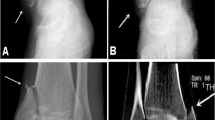Abstract
Background
Optimal treatment of symptomatic accessory navicular bones, generally asymptomatic ‘extra’ ossicles in the front interior ankle, remains debated.
Objective
Incidence and type of accessory navicular bones in Chinese patients were examined as a basis for improving diagnostic and treatment standards.
Methods
Accessory navicular bones were retrospectively examined in 1,625 (790 men and 835 women) patients with trauma-induced or progressive symptomatic ankle pain grouped by gender and age from August 2011 to May 2012. Anterior–posterior/oblique X-ray images; presence; type; affected side; modified Coughlin’s classification types 1, 2A, 2B, and 3; and subgroups a–c were recorded.
Results
Accessory navicular bones were found in 329 (20.2 %) patients (143 men and 186 women; mean age, 47.24 ± 18.34, ranging 14–96 years). Patients aged 51–60 exhibited most accessory navicular bones (29.7 %), with risk slightly higher in women and generally increasing from minimal 10.9 % at ages 11–20 to age 51 and thereafter declining to 0.4 % by age 90. The incidence was 41.6 % for Type 1 (Type 1a: 9.1 %, Type 1b: 15.5 %, and Type 1c: 19.4 %), 36.8 % for Type 2 (Type 2Aa: 2.1 %, Type 2Ab: 13.7 %, Type 2Ac: 5.1 %, Type 2Ba: 2.1 %, 2Bb: 2.1 %, and 2Bc: 11.6 %), and 21.6 % for Type 3 (Type 3a: 4.5 %, Type 3b: 14 %, and Type 3c: 3.0 %).
Conclusions
Approximately one-fifth (20.3 %) of ankle pain patients exhibited accessory navicular bones, with Type 2 most common and middle-aged patients most commonly affected. Thus, accessory navicular bones may be less rare than previously thought, underlying treatable symptomatic conditions of foot pain and deformity.





Similar content being viewed by others
References
Bencardino JT, Rosenberg ZS (2001) MR imaging and CT in the assessment of osseous abnormalities of the ankle and foot. Magn Reson Imaging Clin N Am 9:567–578
Chen YJ, Hsu RW, Liang SC (1997) Degeneration of the accessory navicular synchondrosis presenting as rupture of the posterior tibial tendon. J Bone Jt Surg Am 79:1791–1798
Choi YS, Lee KT, Kang HS, Kim EK (2004) MR imaging findings of painful type II accessory navicular bone: correlation with surgical and pathologic studies. Korean J Radiol 5:274–279
Coskun N, Yuksel M, Cevener M et al (2009) Incidence of accessory ossicles and sesamoid bones in the feet: a radiographic study of the Turkish subjects. Surg Radiol Anat 31:19–24
Coughlin M (2006) Sesamoid and accessory bones of the foot. In: Coughlin M (ed) Surgery of the foot and ankle, 8th edn. Elsevier, Amsterdam, pp 590–595
Fredrick LA, Beall DP, Ly JQ, Fish JR (2005) The symptomatic accessory navicular bone: a report and discussion of the clinical presentation. Curr Probl Diagn Radiol 34:47–50
Geist E (1914) Supernumerary bone of the foot: a roentgen study of the feet of 100 normal individuals. Am J Orthop Surg 12:403
Geist ES (1925) The accessory scaphoid bone. J Bone Jt Surg 7:570–574
Grogan DP, Gasser SI, Ogden JA (1989) The painful accessory navicular: a clinical and histopathological study. Foot Ankle 10:164–169
Kiter E, Gunal I, Turgut A, Kose N (2000) Evaluation of simple excision in the treatment of symptomatic accessory navicular associated with flat feet. J Orthop Sci 5:333–335
Lawson JP (1994) International Skeletal Society Lecture in honor of Howard D. Dorfman. Clinically significant radiologic anatomic variants of the skeleton. Am J Roentgenol 163:249–255
Lawson JP, Ogden JA, Sella E, Barwick KW (1984) The painful accessory navicular. Skelet Radiol 12:250–262
Mellado JM, Ramos A, Salvado E, Camins A, Danus M, Sauri A (2003) Accessory ossicles and sesamoid bones of the ankle and foot: imaging findings, clinical significance and differential diagnosis. Eur Radiol 13(Suppl 4):L164–L177
Miller TT (2002) Painful accessory bones of the foot. Semin Musculoskelet Radiol 6:153–161
Mosel LD, Kat E, Voyvodic F (2004) Imaging of the symptomatic type II accessory navicular bone. Australas Radiol 48:267–271
Mygind HB (1953) The accessory tarsal scaphoid; clinical features and treatment. Acta Orthop Scand 23:142–151
Nakayama S, Sugimoto K, Takakura Y, Tanaka Y, Kasanami R (2005) Percutaneous drilling of symptomatic accessory navicular in young athletes. Am J Sports Med 33:531–535
Romanowski CA, Barrington NA (1992) The accessory navicular—an important cause of medial foot pain. Clin Radiol 46:261–264
Sarrafian SK (1993) Osteology. In: Sarrafian SK (ed) Anatomy of the foot and ankle. Lippincott, Philadelphia, pp 89–112
Sella EJ, Lawson JP (1987) Biomechanics of the accessory navicular synchondrosis. Foot Ankle 8:156–163
Conflict of interest
The authors declare no conflicts of interest.
Author information
Authors and Affiliations
Corresponding author
Additional information
J. Huang and Y. Zhang contributed equally to this study.
Rights and permissions
About this article
Cite this article
Huang, J., Zhang, Y., Ma, X. et al. Accessory navicular bone incidence in Chinese patients: a retrospective analysis of X-rays following trauma or progressive pain onset. Surg Radiol Anat 36, 167–172 (2014). https://doi.org/10.1007/s00276-013-1158-5
Received:
Accepted:
Published:
Issue Date:
DOI: https://doi.org/10.1007/s00276-013-1158-5




